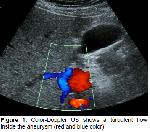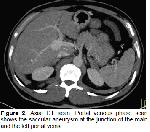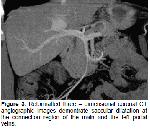Intrahepatic portal vein aneurysm is still a rare
vascular abnormality although new imaging modalities
have been developed
5. Portal vein aneurysm can be
defined as a localized dilatation of the portal vein beyond
normal limits
6 and can be divided into extrahepatic and
intrahepatic types. Main portal vein and its intrahepatic
branches are the most commonly involved vessels
although any portion of the portal venous system might
be affected
7. Although long debated, the pathogenesis
of portal venous system aneurysms has remained
controversial
5,8. A portal venous system aneurysm
may be congenital or acquired as a result of weakening
of the vascular wall.
Chronic liver disease, portal hypertension,
pancreatitis trauma, and the effect of surgery have been
reported as acquired causes of portal venous system
aneurysm2,5,9. In our case, the aneurysm may be of
a congenital origin since there was no identifiable cause.
Majority of cases are clinically asymptomatic. In few
patients, abdominal pain due to compression of adjacent
structures, jaundice by compression of the biliary ducts,
or gastrointestinal bleeding due to rupture of biliary
system were reported10. Portal vein aneurysms are
frequently identified with US or Doppler US and
confirmed with dynamic or multiphasic CT. Treatment of
a portal vein aneurysm depends basically on the
patient's initial clinical symptoms and the presence of
associated portal hypertension1. Most portal venous
system aneurysms require no treatment and follow-up is
sufficient5.
In conclusion, portal vein aneurysm is a vascular
pathology also seen in asymptomatic patients without
portal hypertension. Treatment is unnecessary in
asymptomatic cases but radiological follow-up is
warranted for complications of the aneurysm.





